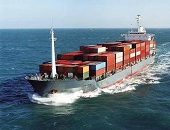Import and export price growth continues although the year-over-year rate of increase slowed for imports.

Analyst Opinion of the Import / Export Price Situation
The elephant in this significant inflation is fuel / oil and agriculture commodities. If one ignores these commodities, the year-over-year inflation rate for imports and exports is much lower than the CPI. Another way to look at this data is that overall – import and export data is now inflating faster than other price indices.
Import Oil prices were down 3.8 % month-over-month, and export agricultural prices were up 0.9 %.
There is only marginal correlation between economic activity, recessions and export / import prices. Prices can be rising or falling going into a recession or entering a period of expansion. Econintersect follows this data series to adjust economic activity for the effects of inflation where there are clear relationships.
Econintersect follows this series to adjust data for inflation.
Year-over-Year Change – Import Prices (blue line) and Export Prices (red line)

There are three cases of deflation outside of a recession – early 1990?s, late 1990?s, and mid 2000?s. Import price deflation is normally associated with strengthening of the dollar relative to other currencies.
According to the press release:
All Imports: Import prices fell 0.2 percent in March, after increasing 1.4 percent over the previous 3 months. Prior to the March downturn, import prices trended up over most of the past 12 months, advancing 4.2 percent between March 2016 and March 2017. In contrast, import prices fell 6.1 percent for the previous 12-month period.
All Exports: Prices for U.S. exports rose 0.2 percent in March, continuing an upward trend since the index last fell on a monthly basis in August. Higher prices for agricultural exports and nonagricultural exports each contributed to the advance in March. U.S. export prices also increased over the past year, rising 3.6 percent for the year ended in March. That matched the 12-month advance recorded in December 2011 and was the largest over-the-year increase since the index rose 4.8 percent in November 2011.













Leave A Comment